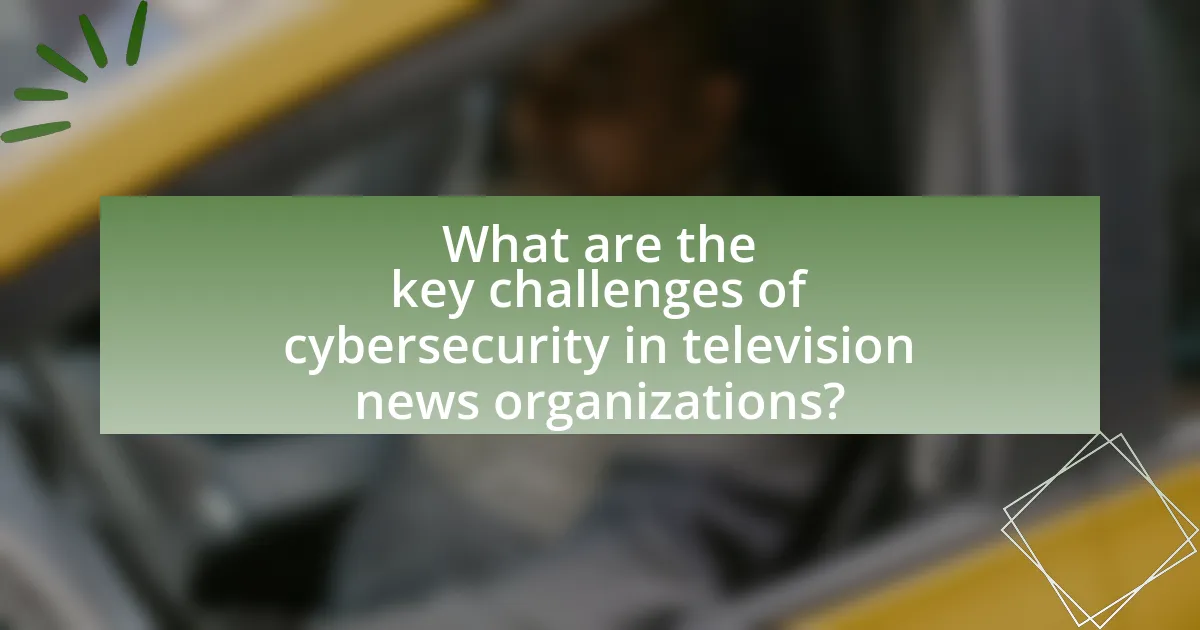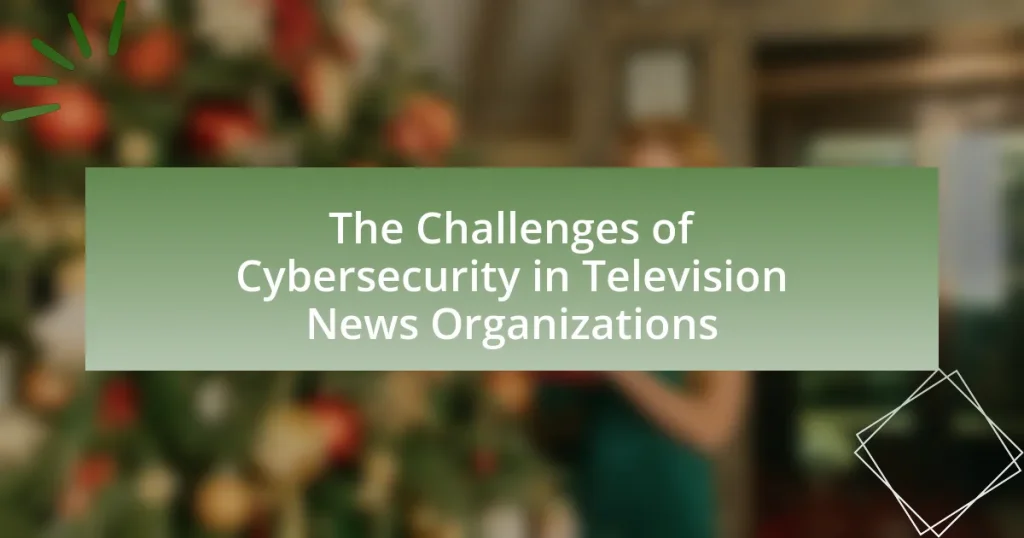The article focuses on the challenges of cybersecurity faced by television news organizations, highlighting the need to protect sensitive data, safeguard against cyberattacks, and maintain the integrity of news broadcasts. It discusses specific cyber threats such as ransomware, phishing, and denial-of-service attacks that target these organizations, along with the common vulnerabilities they encounter. The impact of these cyber threats on operations, public trust, and the overall effectiveness of news reporting is examined, alongside current cybersecurity practices and technologies being implemented to mitigate risks. Additionally, the article outlines the importance of employee training, incident response plans, and collaboration with cybersecurity experts to enhance security measures within the industry.

What are the key challenges of cybersecurity in television news organizations?
The key challenges of cybersecurity in television news organizations include protecting sensitive data, safeguarding against cyberattacks, and ensuring the integrity of news broadcasts. Television news organizations handle vast amounts of confidential information, including sources and unreleased stories, making them attractive targets for hackers. For instance, a 2021 report by the Cybersecurity and Infrastructure Security Agency highlighted that media organizations faced increased phishing attacks, which can lead to data breaches and operational disruptions. Additionally, the rapid pace of news production often leads to inadequate cybersecurity measures being implemented, further exposing these organizations to risks.
How do cyber threats specifically target television news organizations?
Cyber threats specifically target television news organizations through tactics such as ransomware attacks, phishing schemes, and denial-of-service attacks. These organizations are often seen as high-value targets due to their access to sensitive information and their role in disseminating news to the public. For instance, in 2020, the news organization Sinclair Broadcast Group experienced a ransomware attack that disrupted its operations, highlighting the vulnerability of media outlets to such threats. Additionally, phishing attacks are frequently employed to gain unauthorized access to journalists’ email accounts, which can lead to the exposure of confidential sources and sensitive information. The increasing reliance on digital platforms for news dissemination further amplifies these risks, making television news organizations particularly susceptible to cyber threats.
What types of cyber attacks are most common in this sector?
The most common types of cyber attacks in television news organizations include phishing attacks, ransomware, and Distributed Denial of Service (DDoS) attacks. Phishing attacks target employees to gain access to sensitive information, with a significant increase in such incidents reported in the media sector, as evidenced by a 2021 report from the Cybersecurity and Infrastructure Security Agency (CISA) indicating that 90% of data breaches involve phishing. Ransomware attacks have also surged, with the FBI reporting a 300% increase in ransomware incidents in 2020, affecting news organizations’ operations and data integrity. Additionally, DDoS attacks disrupt services by overwhelming networks, which has been a tactic used against several high-profile news outlets, as noted in a 2022 analysis by the cybersecurity firm Cloudflare, highlighting the vulnerability of media organizations to such disruptions.
How do these attacks impact the operations of news organizations?
Cyberattacks significantly disrupt the operations of news organizations by compromising their ability to gather, produce, and disseminate news. These attacks can lead to data breaches, loss of sensitive information, and operational downtime, which directly affects news reporting and audience trust. For instance, a 2020 report by the Cybersecurity and Infrastructure Security Agency highlighted that ransomware attacks on media outlets resulted in the temporary shutdown of news production systems, delaying critical news coverage. Additionally, the financial burden of recovering from such attacks can divert resources away from journalistic activities, further hampering the organization’s effectiveness in delivering timely and accurate news.
Why is cybersecurity particularly important for television news organizations?
Cybersecurity is particularly important for television news organizations because they handle sensitive information and are prime targets for cyberattacks. These organizations often possess confidential data, including personal information of sources and employees, which can be exploited if breached. For instance, in 2020, a significant cyberattack on a major television network resulted in the unauthorized access of sensitive information, highlighting the vulnerabilities within the industry. Additionally, news organizations face threats such as misinformation campaigns and hacking attempts aimed at disrupting their operations or credibility. Protecting against these threats is essential to maintain journalistic integrity and public trust.
What sensitive information do these organizations handle?
Television news organizations handle sensitive information including personal data of employees and sources, confidential news reports, and proprietary content. This information is critical for maintaining journalistic integrity and protecting the identities of whistleblowers and informants. For instance, the unauthorized disclosure of a source’s identity can lead to legal repercussions and endanger lives, as highlighted by the Society of Professional Journalists, which emphasizes the importance of safeguarding such information to uphold ethical standards in journalism.
How can breaches affect public trust in news media?
Breaches can significantly undermine public trust in news media by exposing sensitive information and compromising journalistic integrity. When news organizations experience data breaches, the public may perceive them as unreliable or incapable of safeguarding information, leading to skepticism about the accuracy and credibility of their reporting. For instance, a 2020 survey by the Pew Research Center indicated that 71% of Americans believe that news organizations are often influenced by outside pressures, which can be exacerbated by breaches that reveal potential biases or conflicts of interest. This erosion of trust can result in decreased audience engagement and a reluctance to rely on news media for accurate information.
What are the current cybersecurity practices in television news organizations?
Current cybersecurity practices in television news organizations include implementing multi-factor authentication, regular software updates, and employee training on phishing and social engineering threats. These organizations prioritize securing their networks and data to protect sensitive information and maintain operational integrity. For instance, a 2022 report by the Cybersecurity and Infrastructure Security Agency highlighted that 70% of media companies have adopted advanced threat detection systems to mitigate risks associated with cyberattacks. Additionally, many news organizations conduct regular security audits and collaborate with cybersecurity firms to enhance their defenses against evolving threats.
How effective are these practices in mitigating risks?
These practices are highly effective in mitigating risks associated with cybersecurity in television news organizations. Implementing robust cybersecurity measures, such as regular software updates, employee training, and incident response plans, significantly reduces vulnerabilities. For instance, a study by the Ponemon Institute found that organizations with comprehensive cybersecurity training programs experience 70% fewer security incidents. Additionally, the use of advanced encryption and multi-factor authentication has been shown to decrease the likelihood of data breaches by up to 80%, according to research published by Verizon in their Data Breach Investigations Report.
What technologies are being utilized to enhance cybersecurity?
Artificial intelligence and machine learning are being utilized to enhance cybersecurity. These technologies enable organizations to analyze vast amounts of data for patterns indicative of cyber threats, allowing for proactive threat detection and response. For instance, AI-driven systems can identify anomalies in network traffic that may signify a breach, significantly reducing response times. Additionally, encryption technologies protect sensitive data by making it unreadable to unauthorized users, thereby safeguarding information integrity. According to a report by Cybersecurity Ventures, global spending on AI in cybersecurity is projected to reach $34 billion by 2026, highlighting the growing reliance on these technologies to combat cyber threats effectively.
What are the implications of cybersecurity challenges for news reporting?
Cybersecurity challenges significantly impact news reporting by compromising the integrity and confidentiality of information. When news organizations face cyber threats, such as hacking or data breaches, the reliability of their reporting can be undermined, leading to misinformation being disseminated. For instance, a 2021 report by the Cybersecurity and Infrastructure Security Agency highlighted that 70% of news organizations experienced cyber incidents that disrupted their operations. This disruption can result in delays in reporting, loss of sensitive sources, and erosion of public trust in the media. Furthermore, cybersecurity breaches can expose journalists to risks, including harassment or retaliation, thereby affecting their ability to report freely and safely.
How do cybersecurity challenges influence the public’s perception of news organizations?
Cybersecurity challenges significantly influence the public’s perception of news organizations by eroding trust and credibility. When news organizations experience data breaches or cyberattacks, the public often questions their ability to protect sensitive information, which can lead to skepticism about the accuracy and reliability of the news they provide. For instance, a 2021 survey by the Pew Research Center found that 70% of respondents expressed concern about the security of their personal information when engaging with news websites, indicating a direct correlation between cybersecurity issues and public trust. This erosion of trust can result in decreased audience engagement and a shift towards alternative news sources perceived as more secure.

What are the specific vulnerabilities faced by television news organizations?
Television news organizations face specific vulnerabilities including cyberattacks, misinformation, and data breaches. Cyberattacks, such as ransomware, can disrupt operations and compromise sensitive information; for instance, the 2020 ransomware attack on a major U.S. television network resulted in significant operational downtime and financial loss. Misinformation poses a threat to credibility and audience trust, as seen during the COVID-19 pandemic when false narratives spread rapidly through social media, impacting public perception and safety. Data breaches can expose personal information of employees and sources, leading to legal repercussions and loss of trust; a notable example is the 2017 breach of a major news organization that leaked confidential information. These vulnerabilities highlight the critical need for robust cybersecurity measures in the television news sector.
How does the use of technology expose news organizations to cyber threats?
The use of technology exposes news organizations to cyber threats by increasing their vulnerability to hacking, data breaches, and malware attacks. As news organizations adopt digital platforms for content distribution, they often rely on interconnected systems that can be exploited by cybercriminals. For instance, a report by the Cybersecurity & Infrastructure Security Agency (CISA) highlights that media organizations are prime targets for ransomware attacks, which can disrupt operations and compromise sensitive information. Additionally, the integration of social media and online communication tools can lead to phishing attacks, where employees may inadvertently provide access to malicious actors. These factors collectively illustrate how technological advancements, while beneficial for news dissemination, simultaneously create significant cybersecurity risks.
What role do social media platforms play in cybersecurity vulnerabilities?
Social media platforms significantly contribute to cybersecurity vulnerabilities by serving as channels for misinformation, phishing attacks, and data breaches. These platforms often lack robust security measures, making them attractive targets for cybercriminals. For instance, a 2021 report by the Cybersecurity and Infrastructure Security Agency (CISA) highlighted that 70% of organizations experienced social engineering attacks via social media, where attackers impersonate trusted entities to extract sensitive information. Additionally, the rapid sharing of information on these platforms can lead to the dissemination of malicious links, further compromising user security.
How does remote work impact cybersecurity in news organizations?
Remote work significantly increases cybersecurity risks in news organizations by exposing sensitive data to unsecured networks and personal devices. The shift to remote environments often leads to inadequate security measures, such as the use of weak passwords and lack of multi-factor authentication, making systems more vulnerable to cyberattacks. According to a report by Cybersecurity & Infrastructure Security Agency (CISA), remote work has led to a 400% increase in cyberattacks, highlighting the urgent need for robust cybersecurity protocols in news organizations. Additionally, the reliance on virtual communication tools can create opportunities for phishing attacks, further compromising the integrity of journalistic content and confidential information.
What human factors contribute to cybersecurity risks in television news organizations?
Human factors that contribute to cybersecurity risks in television news organizations include employee negligence, lack of cybersecurity training, and insider threats. Employee negligence often arises from poor password management and failure to recognize phishing attempts, which can lead to unauthorized access to sensitive information. A study by the Ponemon Institute found that 60% of data breaches are caused by human error, highlighting the critical role of employee behavior in cybersecurity vulnerabilities. Additionally, the lack of comprehensive cybersecurity training leaves staff unprepared to handle potential threats, increasing the likelihood of successful cyberattacks. Insider threats, whether intentional or accidental, further exacerbate these risks, as employees may inadvertently compromise security protocols or intentionally misuse access to sensitive data.
How does employee training affect cybersecurity awareness?
Employee training significantly enhances cybersecurity awareness among staff in television news organizations. By providing targeted education on potential threats, such as phishing and malware, employees become more vigilant and capable of identifying suspicious activities. Research indicates that organizations with regular cybersecurity training experience a 70% reduction in successful phishing attacks, demonstrating the effectiveness of such programs. Furthermore, continuous training fosters a culture of security, where employees feel responsible for protecting sensitive information, thereby reducing the likelihood of security breaches.
What are the consequences of insider threats in this context?
Insider threats in television news organizations can lead to significant data breaches, financial losses, and reputational damage. These threats often result in unauthorized access to sensitive information, which can compromise journalistic integrity and public trust. For instance, a report by the Ponemon Institute indicates that insider threats can cost organizations an average of $11.45 million annually, highlighting the financial impact. Additionally, incidents involving insider threats can lead to the exposure of confidential sources or sensitive stories, undermining the organization’s credibility and potentially affecting its audience engagement.
What regulatory and compliance challenges do television news organizations face?
Television news organizations face significant regulatory and compliance challenges primarily related to data privacy, content regulation, and cybersecurity. These organizations must adhere to laws such as the Federal Communications Commission (FCC) regulations, which govern broadcasting standards and content, including issues of decency and misinformation. Additionally, they are required to comply with data protection laws like the General Data Protection Regulation (GDPR) in Europe and the California Consumer Privacy Act (CCPA) in the United States, which impose strict guidelines on how personal data is collected, stored, and used.
Furthermore, the rise of cyber threats necessitates compliance with cybersecurity frameworks such as the National Institute of Standards and Technology (NIST) Cybersecurity Framework, which outlines best practices for managing cybersecurity risks. Failure to comply with these regulations can result in substantial fines and legal repercussions, highlighting the critical need for television news organizations to implement robust compliance programs and cybersecurity measures.
How do these challenges affect the overall cybersecurity strategy?
The challenges faced by television news organizations significantly undermine their overall cybersecurity strategy by exposing vulnerabilities that can lead to data breaches and operational disruptions. For instance, the increasing sophistication of cyberattacks, such as ransomware, forces news organizations to allocate more resources to incident response and recovery, detracting from proactive security measures. Additionally, the rapid pace of technological change in broadcasting can lead to outdated systems that are more susceptible to attacks, further complicating the cybersecurity landscape. According to a report by the Cybersecurity and Infrastructure Security Agency, 60% of small to medium-sized businesses, including media organizations, experience a cyberattack within six months of being compromised, highlighting the urgent need for robust cybersecurity frameworks.

What strategies can television news organizations implement to enhance cybersecurity?
Television news organizations can enhance cybersecurity by implementing multi-factor authentication (MFA) for all user accounts. MFA significantly reduces the risk of unauthorized access by requiring multiple forms of verification, such as passwords combined with biometric data or security tokens. According to a report by the Cybersecurity & Infrastructure Security Agency (CISA), organizations that utilize MFA can prevent 99.9% of automated cyberattacks. Additionally, regular cybersecurity training for employees can help raise awareness about phishing attacks and safe online practices, further strengthening the organization’s defenses. Implementing a robust incident response plan ensures that news organizations can quickly address and mitigate any security breaches that occur.
What best practices should be adopted for cybersecurity in news organizations?
News organizations should adopt a multi-layered cybersecurity strategy that includes employee training, regular software updates, strong password policies, and data encryption. Employee training is crucial, as studies show that human error accounts for 95% of cybersecurity breaches; therefore, educating staff on recognizing phishing attempts and secure practices can significantly reduce risks. Regular software updates ensure that systems are protected against known vulnerabilities, while strong password policies, including the use of multi-factor authentication, enhance access security. Data encryption protects sensitive information both in transit and at rest, making it unreadable to unauthorized users. Implementing these best practices can help news organizations mitigate cybersecurity threats effectively.
How can organizations develop a robust incident response plan?
Organizations can develop a robust incident response plan by following a structured approach that includes preparation, detection, analysis, containment, eradication, recovery, and post-incident review. This framework ensures that all aspects of incident management are addressed systematically.
Preparation involves training staff and establishing communication protocols, which are critical for effective response. Detection and analysis require implementing monitoring tools to identify potential threats quickly. Containment strategies must be in place to limit the impact of an incident, while eradication focuses on removing the threat from the environment. Recovery processes should restore systems to normal operations, and post-incident reviews help refine the plan based on lessons learned.
According to the National Institute of Standards and Technology (NIST), organizations that adopt a comprehensive incident response framework can reduce the impact of security incidents by up to 50%. This statistic underscores the importance of a well-defined incident response plan in mitigating risks associated with cybersecurity threats, particularly in sensitive sectors like television news organizations.
What role does regular security training play in strengthening defenses?
Regular security training plays a crucial role in strengthening defenses by enhancing employees’ awareness of cybersecurity threats and best practices. This training equips staff with the knowledge to recognize phishing attempts, secure sensitive information, and respond effectively to security incidents. According to a report by the Ponemon Institute, organizations that conduct regular security awareness training can reduce the likelihood of a successful cyber attack by up to 70%. This statistic underscores the effectiveness of ongoing education in mitigating risks and fortifying the overall security posture of television news organizations.
How can collaboration with cybersecurity experts improve security measures?
Collaboration with cybersecurity experts significantly enhances security measures by integrating specialized knowledge and skills that address specific vulnerabilities. Cybersecurity experts possess advanced understanding of threat landscapes, enabling organizations to identify and mitigate risks effectively. For instance, a study by the Ponemon Institute found that organizations employing cybersecurity professionals experienced 50% fewer data breaches compared to those without such expertise. This collaboration allows for the implementation of tailored security protocols, continuous monitoring, and incident response strategies that are crucial for protecting sensitive information in television news organizations.
What partnerships can be formed to enhance cybersecurity resilience?
Partnerships that can be formed to enhance cybersecurity resilience include collaborations between television news organizations and cybersecurity firms, government agencies, and academic institutions. Cybersecurity firms can provide specialized expertise and technology solutions to protect sensitive data and infrastructure. Government agencies, such as the Department of Homeland Security, can offer resources, threat intelligence, and training programs tailored for media organizations. Academic institutions can contribute research and development of innovative cybersecurity practices, fostering a pipeline of skilled professionals. These partnerships collectively strengthen the overall security posture of television news organizations by sharing knowledge, resources, and best practices.
How can news organizations stay updated on emerging cyber threats?
News organizations can stay updated on emerging cyber threats by establishing partnerships with cybersecurity firms and participating in threat intelligence sharing networks. These collaborations enable access to real-time information about vulnerabilities and attack trends, which is crucial for proactive defense. For instance, organizations like the Cyber Threat Alliance provide resources and data that help media outlets understand the evolving landscape of cyber threats. Additionally, subscribing to cybersecurity news feeds and attending industry conferences can further enhance awareness and preparedness against potential cyber incidents.
What practical steps can television news organizations take to protect themselves from cyber threats?
Television news organizations can protect themselves from cyber threats by implementing robust cybersecurity measures, including regular software updates, employee training, and the use of advanced firewalls. Regular software updates ensure that systems are equipped with the latest security patches, reducing vulnerabilities. Employee training is crucial, as it educates staff on recognizing phishing attempts and other cyber threats, which is essential given that human error is a significant factor in many breaches. Advanced firewalls act as a barrier against unauthorized access, monitoring incoming and outgoing traffic for suspicious activity. According to a report by the Cybersecurity & Infrastructure Security Agency, organizations that adopt a multi-layered security approach significantly reduce their risk of cyber incidents.




